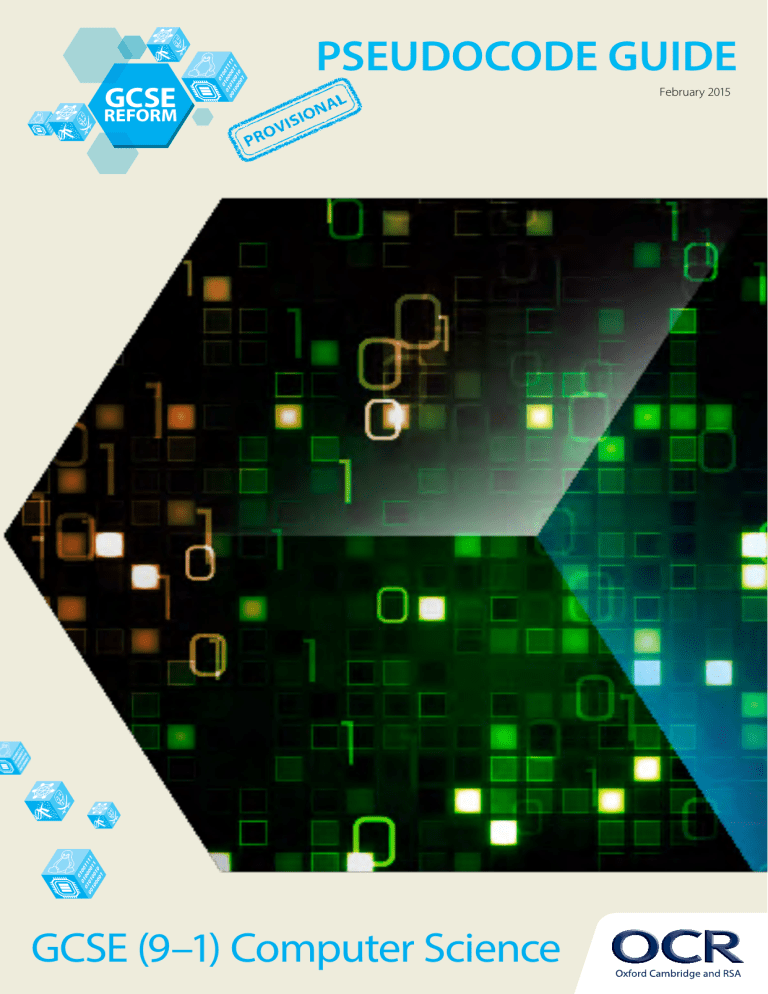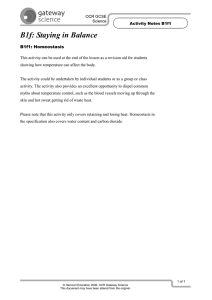
GCSE
PSEUDOCODE GUIDE
REFORM
GCSE (9–1) Computer Science
February 2015
We will inform centres about any changes to the specification. We will also
publish changes on our website. The latest version of our specification will
always be the one on our website (www.ocr.org.uk) and this may differ from
printed versions.
Copyright © 2015 OCR. All rights reserved.
Copyright
OCR retains the copyright on all its publications, including the specifications.
However, registered centres for OCR are permitted to copy material from this
specification booklet for their own internal use.
Oxford Cambridge and RSA Examinations is a Company Limited by Guarantee.
Registered in England. Registered company number 3484466.
Registered office: 1 Hills Road
Cambridge
CB1 2EU
OCR is an exempt charity.
This resource is an exemplar of the types of materials that will be provided to assist in the teaching of the new
qualifications being developed for first teaching in 2016. It can be used to teach existing qualifications but may be
updated in the future to reflect changes in the new qualifications. Please check the OCR website for updates and
additional resources being released. We would welcome your feedback so please get in touch.
GCSE (9–1) COMPUTER SCIENCE
PSEUDOCODE GUIDE
CONTENTS
INTRODUCTION4
VARIABLES 4
CASTING4
OUTPUTTING TO SCREEN 4
ITERATION – COUNT CONTROLLED 5
ITERATION – CONDITION CONTROLLED 5
LOGICAL OPERATORS 6
SELECTION 7
STRING HANDLING 8
SUBROUTINES 9
ARRAYS 10
READING TO AND WRITING FROM FILES 11
COMMENTS 11
3
GCSE (9–1) COMPUTER SCIENCE
PSEUDOCODE GUIDE
INTRODUCTION
The following guide shows the format pseudocode will appear in the examined components. It is provided to allow you to give learners
familiarity before the exam. Learners are not expected to memorise the syntax of this pseudocode and when asked may provide answers in
any style of pseudocode they choose providing its meaning could be reasonably inferred by a competent programmer.
Variables
Variables are assigned using the = operator.
x=3
name=”Bob”
A variable is declared the first time a value is assigned. It assumes the data type of the value it is given.
Variables declared inside a function or procedure are local to that subroutine.
Variables in the main program can be made global with the keyword global.
global userid = 123
Casting
Variables can be typecast using the int str and float functions
str(3) returns “3”
int(“3”) returns 3
float(“3.14”) returns 3.14
Outputting to Screen
print(string)
Example:
print(“hello”)
Taking Input from User
variable=input(prompt to user)
Example:
name=input(“Please enter your name”)
4
GCSE (9–1) COMPUTER SCIENCE
PSEUDOCODE GUIDE
Iteration - Count Controlled
for i=0 to 7
print(“Hello”)
next i
Will print hello 8 times (0-7 inclusive).
Iteration - Condition Controlled
while answer!=”computer”
answer=input(“What is the password?”)
endwhile
do
answer=input(“What is the password?”)
until answer==”computer”
5
GCSE (9–1) COMPUTER SCIENCE
PSEUDOCODE GUIDE
Logical Operators
AND OR NOT
eg
while x<=5 AND flag==false
AND
OR
NOT
(conjunction)
(disjunction)
(negation)
OUTPUT
INPUT
A
B
A ^B
A
B
T
T
T
T
T
T
F
F
T
F
T
F
F
F
F
Comparison Operators
of ¬ A
OUTPUT
A
¬A
T
T
F
F
T
F
T
F
T
T
F
F
F
A
^
INPUT
B
Aritmetic Operators
==
Equal to
+
Addition eg x=6+5 gives 11
!=
Not equal to
-
Subtraction eg x=6-5 gives 1
<
Less than
*
Multiplication eg x=12*2 gives 24
<=
Less than or equal to
/
Division eg x=12/2 gives 6
>
Greater than
MOD
Modulus eg 12MOD5 gives 2
>=
Greater than or equal to
DIV
Quotient eg 17DIV5 gives 3
^
Exponentiation eg 3^4 gives 81
6
GCSE (9–1) COMPUTER SCIENCE
PSEUDOCODE GUIDE
Selection
Selection will be carried out with if/else and switch/case:
if/else
if entry==”a” then
print(“You selected A”)
elseif entry==”b” then
print(“You selected B”)
else
print(“Unrecognised selection”)
endif
switch/case
switch entry:
case “A”:
print(“You selected A”)
case “B”:
print(“You selected B”)
default:
print(“Unrecognised selection”)
endswitch
7
GCSE (9–1) COMPUTER SCIENCE
PSEUDOCODE GUIDE
String Handling
To get the length of a string:
stringname.length
To get a substring:
stringname.subString(startingPosition, numberOfCharacters)
NB: The string will start with the 0th character.
Example:
someText=”Computer Science”
print(someText.length)
print(someText.substring(3,3))
Will display:
16
put
8
GCSE (9–1) COMPUTER SCIENCE
PSEUDOCODE GUIDE
Subroutines
function triple(number)
return number*3
endfunction
Called from main program
y=triple(7)
procedure greeting(name)
print(“hello”+name)
endprocedure
Called from main program
greeting(“Hamish”)
Unless stated values passed to subroutines can be assumed to be passed by value. If this is relevant to the question byVal
and byRef will be used. In the case below x is passed by value and y is passed by reference.
procedure foobar(x:byVal, y:byRef)
…
…
endprocedure
9
GCSE (9–1) COMPUTER SCIENCE
PSEUDOCODE GUIDE
Arrays
Arrays will be 0 based and declared with the keyword array.
array names[5]
names[0]=”Ahmad”
names[1]=”Ben”
names[2]=”Catherine”
names[3]=”Dana”
names[4]=”Elijah”
print(names[3])
Example of 2D array:
Array board[8,8]
board[0,0]=”rook”
10
GCSE (9–1) COMPUTER SCIENCE
PSEUDOCODE GUIDE
Reading to and Writing from Files
To open a file to read from openRead is used and readLine to return a line of text from the file.
The following program makes x the first line of sample.txt
myFile = openRead(“sample.txt”)
x = myFile.readLine()
myFile.close()
endOfFile() is used to determine the end of the file. The following program will print out the contents of sample.txt
myFile = openRead(“sample.txt”)
while NOT myFile.endOfFile()
print(myFile.readLine())
endwhile
myFile.close()
To open a file to write to openWrite is used and writeLine to add a line of text to the file. In the program below hello world is
made the contents of sample.txt (any previous contents are overwritten).
myFile = openWrite(“sample.txt”)
myFile.writeLine(“Hello World”)
myFile.close()
Comments
Comments are denoted by //
print(“Hello World”) //This is a comment
11
We’d like to know your view on the resources we produce. By clicking on the ‘Like’ or ‘Dislike’ button you can help us to ensure
that our resources work for you. When the email template pops up please add additional comments if you wish and then just
click ‘Send’. Thank you.
If you do not currently offer this OCR qualification but would like to do so, please complete the Expression of Interest Form which
can be found here: www.ocr.org.uk/expression-of-interest
OCR Resources: the small print
OCR’s resources are provided to support the teaching of OCR specifications, but in no way constitute an endorsed teaching method that is required by the Board and the decision to use them lies with the individual
teacher. Whilst every effort is made to ensure the accuracy of the content, OCR cannot be held responsible for any errors or omissions within these resources. We update our resources on a regular basis, so please
check the OCR website to ensure you have the most up to date version.
© OCR 2015 - This resource may be freely copied and distributed, as long as the OCR logo and this message remain intact and OCR is acknowledged as the originator of this work.
OCR acknowledges the use of the following content:
Thumbs up: alex_white/Shutterstock.com, Thumbs down: alex_white/Shutterstock.com
Please get in touch if you want to discuss the accessibility of resources we offer to support delivery of our qualifications: resources.feedback@ocr.org.uk
ocr.org.uk/gcsereform
OCR customer contact centre
General qualifications
Telephone 01223 553998
Facsimile 01223 552627
Email general.qualifications@ocr.org.uk
For staff training purposes and as part of our quality assurance programme your call may be recorded or monitored.
© OCR 2015 Oxford Cambridge and RSA Examinations is a Company Limited by Guarantee. Registered in England.
Registered office 1 Hills Road, Cambridge CB1 2EU. Registered company number 3484466. OCR is an exempt charity.



